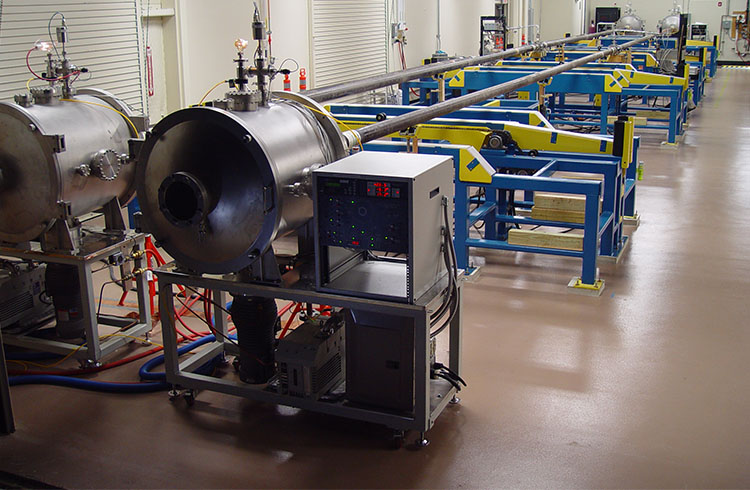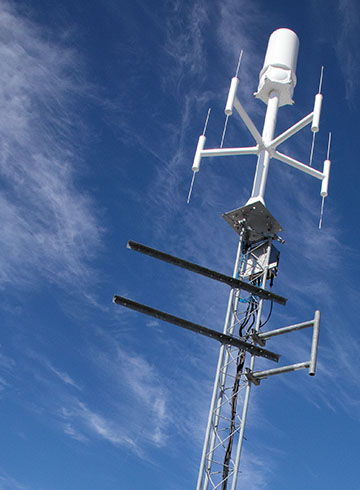Two SwRI-developed technologies were selected as winners of prestigious R&D 100 Awards. R&D World magazine recognized SwRI’s Lotus Superhydrophobic Compositions and Coating Process (LotusFlo™) and AF-369 VHF/UHF Terrestrial Direction-Finding Antenna as being among the 100 most significant innovations for 2019.

Lotus Superhydrophobic Compositions and Coating Process
Substances found in crude oil can clog offshore drilling pipes and require costly chemicals to clear the blockage, which can then pollute the surrounding ocean.
“Offshore oil drilling faces a number of challenges in extracting petroleum from beneath the ocean floor,” said Institute Scientist Dr. Michael Miller, one of LotusFlo’s principal developers. “Pipes are frequently clogged by sticky, tar-like molecular substances derived from petroleum and inorganic scales, mineral deposits that form when water mixes with different types of salty liquids.”
LotusFlo coating technology is superhydrophobic, designed specifically to repel substances that often clog drilling pipes. The coating is applied to pipes under vacuum conditions through a unique process that involves linking several 40-foot sections of pipe together in very low atmospheric pressures. The coupled pipes essentially act as a vacuum chamber, with an end unit on either side of the pipe providing the vacuum source. An electrode is strung through the pipe from one end to the other and suspended in the middle of the pipe.
Volatile molecules introduced into the evacuated pipe are electrically stimulated to produce highly ionized gas molecules, or plasma, along the length of the pipe structure. This causes chemical precursor molecules to form other ions in the plasma, which are then accelerated very rapidly onto the internal surface of the pipe. When the ions collide on the interior surface, they undergo a polymerization reaction that creates a partially inorganic coating. This glass-like coating is what keeps materials from adhering to pipe surfaces.
Questions about LotusFlo? Contact Dr. Michael Miller or +1 210 522 2189.
“SwRI seeks solutions for the world’s most complex problems,” said President and CEO Adam L. Hamilton, P.E. “We are committed to continuously improving the world around us through innovation, and it’s an honor to see the Institute recognized for those efforts at what is widely known as the ‘Oscars of Innovation.’ Since 1963, SwRI has won 45 R&D 100 Awards.”

SwRI applies the LotusFlo superhydrophobic coating, which prevents materials from occluding the flow of oil, to a series of offshore drilling pipes.

SwRI’s award-winning AF-369 VHF/UHF Terrestrial Direction-Finding Antenna provides accurate direction finding of radio frequency transmissions from 20 MHz to 3 GHz.
AF-369 VHF/UHF Terrestrial Direction-Finding Antenna
Mitigating ongoing threats to national security requires timely intelligence data, including signals intelligence obtained through electronic surveillance. The military uses modern signals intelligence systems to collect this information by monitoring electronic communications transmitted over the air.
“To cover so much bandwidth, most DF antenna products need three separate arrays. The patent-pending sleeved electric dipoles we developed cover 80% more bandwidth than conventional dipoles,” said Brandon Nance, a manager in the Defense & Intelligence Solutions Division and the principal developer of the AF-369 antenna. “This improves direction-finding sensitivity tenfold over a significant part of their frequency coverage. That is, we can get the same performance with 10-times weaker signals. And because we are doing more with fewer antennas, the complexity and the overall costs of the antenna system are reduced.”
Direction finding is performed using antenna arrays made up of multiple antenna array elements to sample the incoming wave field. Frequencies typically used for line-of-sight communications are spread across the 20 MHz to 3 GHz RF spectrum, a tremendous amount of bandwidth to monitor.
To monitor this broad spectrum requires multiple arrays, each with elements designed to cover a smaller sub-band of frequencies. Each sub-band typically uses between five and nine antenna elements, with the total number required to cover the full frequency range increasing with the addition of each sub-band. The cost of each DF antenna array, as well as the complexity of the RF receiving system connected to it, drives up costs for both the antenna itself and the system as a whole. SwRI’s innovative sleeved electric dipoles for the AF-369 antenna reduce the number of arrays necessary to monitor a similar amount of bandwidth, thereby lowering the cost of the entire system and simultaneously improving its performance.
Questions about antennas? Contact Brandon Nance or +1 210 522 3294.

